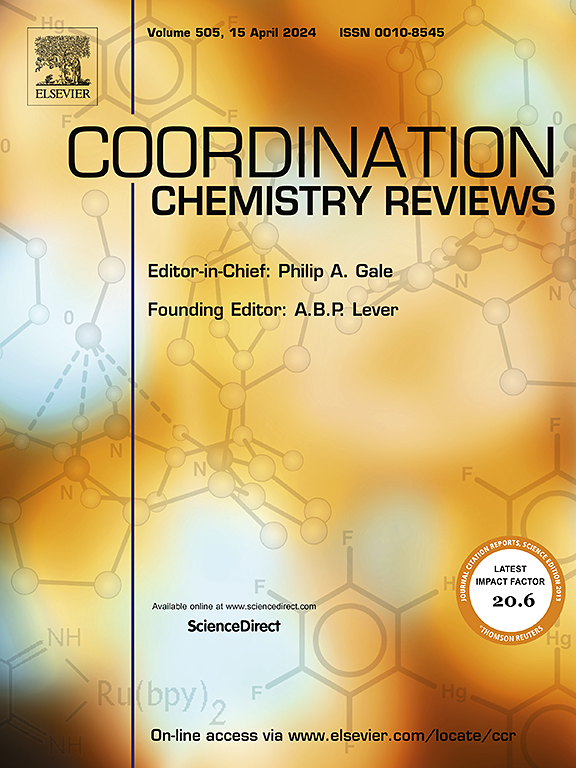Cocatalysts for photocatalysis: Comprehensive insight into interfacial charge transfer mechanism by energy band theory
IF 20.3
1区 化学
Q1 CHEMISTRY, INORGANIC & NUCLEAR
引用次数: 0
Abstract
Cocatalysts have played an important role to reach high-efficiency photocatalysis with semiconductor photocatalysts. Various compositions and microstructures of inorganic and organic nanomaterials have been proposed as cocatalysts, however, consistent understanding on charge transfer mechanism at heterogenous interfaces has not been achieved yet. In this review, the existing cocatalysts are first re-sorted in terms of composition and band structure into (semi)metals, metal compounds (narrow- and wide-bandgap), nonmetals and hybrids, focusing on the underlying mechanism for charge transfer pathway at various cocatalyst–semiconductor interfaces according to energy band theory. Significantly, the polarity of Schottky contact and Ohmic contact for a semiconductor-(semi)metal heterojunction is highlighted, wherein Schottky junctions for electron transfer can be deemed as Ohmic junctions for hole transfer, and vice versa. The specific charge transfer pathway depends on the type of semiconductors, magnitude of interfacial band bending barrier, as well as that whether the metal has plasmic resonance effect. Furthermore, the function of cocatalysts (reduction- or oxidation-type) is distinguished in terms of charge transfer pathway, and consistent understanding on the roles of narrow-bandgap metal-compound cocatalysts is achieved, no matter they are deemed as semimetals or semiconductors in previous studies. Finally, the comprehensive insight into charge transfer pathways at various semiconductor-cocatalyst interfaces is obtained, which provides universal criteria to investigate carrier kinetics within heterojunction photocatalysts.

光催化的辅助催化剂:利用能带理论全面了解界面电荷转移机制
辅助催化剂在半导体光催化剂实现高效光催化方面发挥了重要作用。无机和有机纳米材料的不同组成和微观结构已被提出作为助催化剂,但对非均相界面上的电荷转移机理尚未达成一致的认识。本文首先将现有的共催化剂从组成和能带结构上重新分类为半金属、金属化合物(窄带隙和宽带隙)、非金属和杂化物,并根据能带理论重点研究了各种共催化剂-半导体界面上电荷转移途径的潜在机制。值得注意的是,突出了半导体-(半)金属异质结的肖特基结和欧姆接触的极性,其中电子转移的肖特基结可以视为空穴转移的欧姆结,反之亦然。具体的电荷转移途径取决于半导体的种类、界面带弯曲势垒的大小以及金属是否具有等离子共振效应。此外,从电荷转移途径上区分了共催化剂(还原型或氧化型)的功能,并对窄带隙金属-化合物共催化剂的作用有了一致的认识,无论其在以往的研究中被认为是半金属还是半导体。最后,获得了不同半导体-助催化剂界面上电荷转移途径的全面见解,为研究异质结光催化剂中的载流子动力学提供了通用标准。
本文章由计算机程序翻译,如有差异,请以英文原文为准。
求助全文
约1分钟内获得全文
求助全文
来源期刊

Coordination Chemistry Reviews
化学-无机化学与核化学
CiteScore
34.30
自引率
5.30%
发文量
457
审稿时长
54 days
期刊介绍:
Coordination Chemistry Reviews offers rapid publication of review articles on current and significant topics in coordination chemistry, encompassing organometallic, supramolecular, theoretical, and bioinorganic chemistry. It also covers catalysis, materials chemistry, and metal-organic frameworks from a coordination chemistry perspective. Reviews summarize recent developments or discuss specific techniques, welcoming contributions from both established and emerging researchers.
The journal releases special issues on timely subjects, including those featuring contributions from specific regions or conferences. Occasional full-length book articles are also featured. Additionally, special volumes cover annual reviews of main group chemistry, transition metal group chemistry, and organometallic chemistry. These comprehensive reviews are vital resources for those engaged in coordination chemistry, further establishing Coordination Chemistry Reviews as a hub for insightful surveys in inorganic and physical inorganic chemistry.
 求助内容:
求助内容: 应助结果提醒方式:
应助结果提醒方式:


